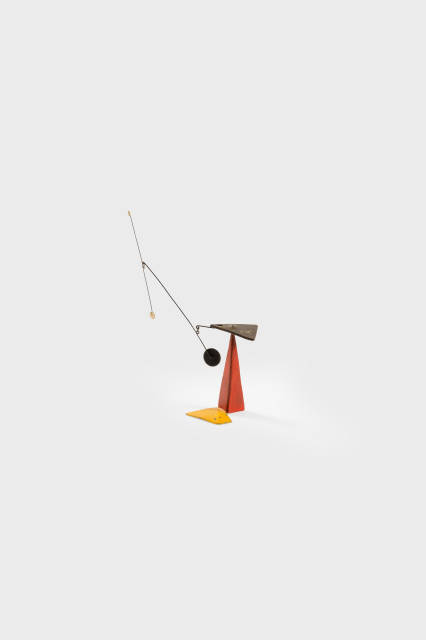- EN
Log in
- Live Auctions
- Past auctions
- More
- Gallery
- Art Dealing
- Publishing
- Kornfeld today
- The Story of Kornfeld
- Information











Sale time 13-09-2024,
about 14:25 h (CET)
(+/- 30 min)
Circa 1958
Sheet iron, wire, coloured
24.5x18x9 cm (upright)
With the monogram "CA"
The Standing mobile is registered with the Calder Foundation, New York, under application number A22176
Studio of the artist, purchased there in 1958 by
Galerie Blanche, Stockholm, purchased there on 22 May 1958 by
The Eberhard W. Kornfeld Collection, Bern
Slight rubbing in yellow and red
The autumn of 1931 in Paris marked a significant turning point in Alexander Calder's artistic career when he created his first kinetic sculpture, giving shape to a completely new type of art. In addition to his ground-breaking "mobiles", which are moved by air circulation, he initially also constructed sculptures powered by motors. These unique works made him famous, and in 1931 he had his first major exhibition in Paris. In 1932 Calder became a member of the artists' group "Abstraction-Création", which included Jean Arp, Piet Mondrian and Jean Hélion. Calder's development towards abstraction was significantly influenced by the group.
To distinguish Calder's free-hanging works, which Marcel Duchamp called "mobiles", from other works, Arp called Calder's stationary objects "stabiles".
After returning to the USA, the artist gradually developed his kinetic sculpture further. Important exhibitions followed, for example in 1943 at the Museum of Modern Art in New York. In his later years, Calder concentrated primarily on large-scale, monumental commissions. However, he also repeatedly created smaller works, such as the "Stabile" offered here, which was created around 1958. It is a cabinet piece, seemingly fragile and yet standing firmly on the ground. Three dots in white and black are held in impressive balance by a solid piece of metal on a yellow-red stand. Calder's playful approach to art is realised with the simplest of means.
Um 1958
Eisenblech, Draht, farbig gefasst
24,5x18x9 cm (stehend)
Mit dem Monogramm "CA"
Das Standing mobile ist in der Calder Foundation, New York, unter der "application number A22176" registriert
Atelier des Künstlers, dort 1958 angekauft von
Galerie Blanche, Stockholm, dort am 22. Mai 1958 angekauft von
Slg. Eberhard W. Kornfeld, Bern
Leichte Abreibungen im Gelb und Rot
In Paris kam es im Herbst 1931 zu einem bedeutenden Wendepunkt in Alexander Calders künstlerischer Laufbahn, als er seine erste kinetische Plastik schuf und damit einer völlig neuen Art von Kunst Gestalt gab. Neben seinen bahnbrechenden "Mobiles", die durch Luftzirkulation bewegt werden, konstruierte er am Anfang auch durch Motoren angetriebene Skulpturen. Diese einzigartigen Werke machten ihn bekannt und 1931 hatte er seine erste grosse Ausstellung in Paris. 1932 wurde Calder Mitglied der Künstlergruppe "Abstraction-Création", der unter anderem Jean Arp, Piet Mondrian und Jean Hélion angehörten. Calders Entwicklung zur Abstraktion wurde massgeblich durch die Gruppe beeinflusst.
Um Calders von Marcel Duchamp als "Mobiles" bezeichneten, frei hängenden Werke von anderen Arbeiten abzugrenzen, nannte Arp Calders stationäre Objekte "Stabiles".
Nach der Rückkehr in die USA entwickelte der Künstler seine kinetische Plastik sukzessive weiter. Es folgten wichtige Ausstellungen, etwa 1943 im Museum of Modern Art in New York. In seinen späteren Jahren konzentrierte sich Calder vor allem auf grossformatige, monumentale Auftragsarbeiten. Daneben entstanden aber auch immer wieder kleinere Werke, darunter etwa das hier angebotene "Stabile", das um 1958 entstanden ist. Es ist ein Kabinettsstück, vermeintlich fragil und doch fest auf dem Grund stehend. Drei Punkte in Weiss und Schwarz werden von einem massiveren Metallstück auf einem gelb-rot gefassten Ständer in eindrücklicher Balance gehalten. Exemplarisch wird Calders Verspieltheit in der Kunst mit einfachsten Mitteln umgesetzt.
| Switzerland | CHF | Individual offer |
| Europe | CHF | Individual offer |
| Overseas | CHF | Individual offer |












